
German postcard by Ross Verlag, no. 7216/1, 1932-1933. Photo: Paramount.

German postcard by Ross Verlag, no. 168/1. Photo: Paramount. Sylvia Sidney and Cary Grant in Madame Butterfly (Marion Gering, 1932).
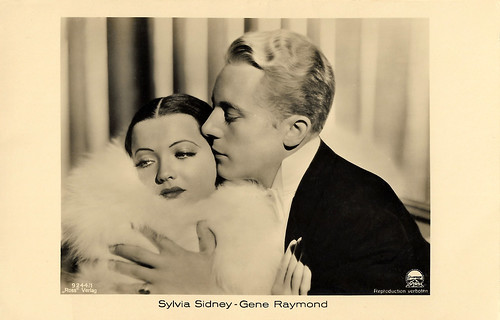
German postcard by Ross Verlag, no. 9244/1, 1935-1936. Photo: Paramount. Sylvia Sidney and Gene Raymond in Behold My Wife! (Mitchell Leisen, 1934).

British postcard in the Film Partners Series, London, no. P 193. Photo: Paramount. Henry Fonda and Sylvia Sidney in The Trail of the Lonesome Pine (Henry Hathaway, 1936).

British Real Photograph postcard by Art Photo, no. 27. Photo: Paramount Pictures Inc.
A reputation for being difficult to work with
Sylvia Sidney was born Sophia Kosow in 1910 in the Bronx, New York. She was the daughter of Rebecca (née Saperstein), a Romanian Jew, and Victor Kosow, a Russian Jewish immigrant who worked as a clothing salesman. Her parents divorced by 1915, and she was adopted by her stepfather Sigmund Sidney, a dentist. Her mother became a dressmaker and renamed herself, Beatrice Sidney.
Now using the surname Sidney, Sylvia became an actress at the age of 15 as a way of overcoming shyness. She became a student of the Theater Guild's School for Acting. One school production was held at a Broadway theatre and in the audience, there was a critic from the New York Times who had nothing but rave reviews for the young Miss Sidney.
On the strength of her performance in New York, Sylvia appeared in a play at the famed Poli Theater in Washington, D.C. More stage productions followed. In 1926, she was seen by a Hollywood talent scout in the production 'Crime' and made her first film appearance later that year in Broadway Nights (Joseph Boyle, 1927).
During the Depression, she appeared in a string of films, often playing the girlfriend or sister of a gangster. 1931 saw her appear in five films, of which, City Streets (Rouben Mamoulian, 1931), made her a star. The sad-eyed Sylvia made a tremendous impact and her screen career was off a running.
Among her other films, that year were: An American Tragedy (Josef von Sternberg, 1931), and Street Scene (King Vidor, 1931). She co-starred with Fredric March in Merrilly We Go To Hell (Dorothy Arzner, 1932). Her other films included Alfred Hitchcock's Sabotage (1936), Fritz Lang's Fury (1936) and You Only Live Once (1937), Dead End (William Wyler, 1937), and The Trail of the Lonesome Pine (Henry Hathaway, 1936), an early three-strip Technicolor film.
She appeared with Gary Cooper, Spencer Tracy, Henry Fonda, Joel McCrea, Fredric March, George Raft, and Cary Grant. During this period, she developed a reputation for being difficult to work with. At the time of making Sabotage (1936) with Alfred Hitchcock, Sidney was one of the highest-paid actresses in the industry, earning $10,000 per week —earning a total of $80,000 for Sabotage.
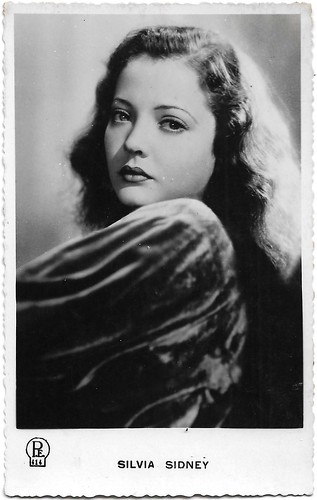
Belgian postcard by P.E. (Photo Edition), no. 414.

British postcard in the "Filmshots" series by Film Weekly. Photo: Paramount. Sylvia Sidney and Edward Arnold in Jennie Gerhardt (Marion Gering, 1933).

British postcard in the "Filmshots" series by Film Weekly. Photo: Paramount. Sylvia Sidney and Greta Meyer in Jennie Gerhardt (Marion Gering, 1933).

British postcard in the Film Shots series by Film Weekly. Photo: Paramount. Sylvia Sidney and George Raft in Pick-up (Marion Gering, 1933).

British postcard in the Film Partners Series, London, no. P 134. Photo: Paramount. Sylvia Sidney and Gene Raymond in Behold My Wife! (Mitchell Leisen, 1934).
Box-office Poison
During the 1940s, the career of Sylvia Sidney diminished somewhat. In The Searching Wind (William Dieterle, 1946), Sidney played a newspaper reporter with convictions who was the alter ego of playwright Lillian Hellman. The film was based on a Broadway play but it just didn't transfer well onto the big screen. The film was widely considered to be too serious and flopped.
The following year, she appeared in another flop, Love From A Stranger (Richard Whorf, 1947). In 1949, exhibitors voted her "box-office poison".
In 1952, she played the role of Fantine in Les Misérables (Lewis Milestone, 1952), and her performance was praised and allowed her opportunities to develop as a character actress. Only three more films followed that decade. There were no films throughout the 1960s.
On TV, she appeared three times on the anthology drama series Playhouse 90 (1956-1960). In 1957, she appeared as Lulu Morgan, mother of singer Helen Morgan in the episode The Helen Morgan Story (George Roy Hill, 1957) featuring Polly Bergen. Four months later, Sidney rejoined her former co-star Bergen on the premiere of the short-lived The Polly Bergen Show (1957-1958).
She also worked in television during the 1960s on such programs as Route 66 (1961-1964), The Defenders (1962), and My Three Sons (1969).
In 1973, Sylvia returned to the big screen in Summer Wishes, Winter Dreams (Gilbert Cates, 1973), starring Joanne Woodward. She received an Academy Award nomination for her supporting role. As an elderly woman, Sidney continued to play supporting screen roles and was identifiable by her husky voice, the result of cigarette smoking.
She was the formidable Miss Coral in the film version of I Never Promised You a Rose Garden (Anthony Page, 1977) and later was cast as Aidan Quinn's grandmother in the television production of An Early Frost (John Erman, 1985) for which she won a Golden Globe Award. She played Aunt Marion in Damien: Omen II (Don Taylor, 1978) opposite William Holden and Lee Grant.
Sylvia Sidney also had key roles as Juno in the mega-hit Beetlejuice (1988) directed by longtime Sidney fan Tim Burton, and in Used People (Beeban Kidron, 1992). Her final role was in Mars Attacks! (1996), another film by Tim Burton, in which she played an elderly woman whose beloved records by Slim Whitman help stop an alien invasion from Mars.
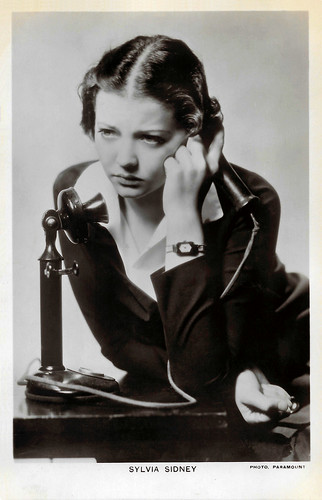
British postcard in the Picturegoer Series, London, no. 572. Photo: Paramount.

French postcard by Editions Chantal, Paris, no. 12. Photo: Paramount.

Dutch postcard, no. 126. Photo: Paramount.

Dutch postcard, no. 560. Photo: Paramount.
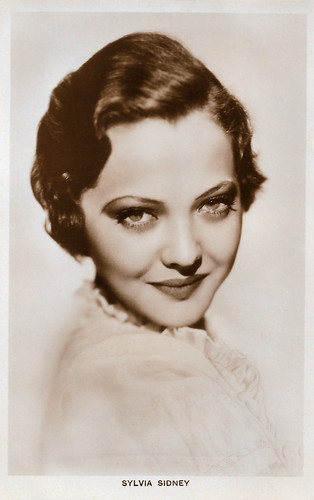
British postcard.

British postcard by Art Photo, no. 173. Sylvia Sidney and George Raft in You and Me (Fritz Lang, 1938).
A Broadway career spanning five decades
On television, Sylvia Sidney appeared in the pilot episode of WKRP in Cincinnati (1978) as the imperious owner of the radio station, and she appeared in a memorable episode of Thirtysomething (1989) as Melissa's tough grandmother, who wanted to leave her granddaughter the family dress business, though Melissa (Melanie Mayron) wanted a career as a photographer.
She also was featured on Starsky & Hutch (1976), The Love Boat (1981), Magnum, P.I. (1983), and Trapper John, M.D.(1984).
Her Broadway career spanned five decades, from her debut performance as a graduate of the Theatre Guild School in 1926 at age 15, in the three-act fantasy 'Prunella' to the Tennessee Williams play 'Vieux Carré' in 1977.
In 1982, Sidney was awarded the George Eastman Award by George Eastman House for a distinguished contribution to the art of film. In 1998 she appeared as the crotchety travel clerk Clia at the beginning of each episode in the short-lived revival of the classic TV series Fantasy Island.
Sylvia Sidney died in 1999, from esophageal cancer at the Lenox Hill Hospital in Manhattan, a month before her 89th birthday. Her remains were cremated.
Sidney was married three times. She first married publisher Bennett Cerf in 1935, but the couple divorced six months later in 1936. She later married actor and acting teacher Luther Adler in 1938, by whom she had her only child, a son Jacob (1939–1987), who died of Lou Gehrig's disease while his mother was still alive. Adler and Sidney divorced in 1946. In 1947, she married radio producer and announcer Carlton Alsop. They divorced in 1951.
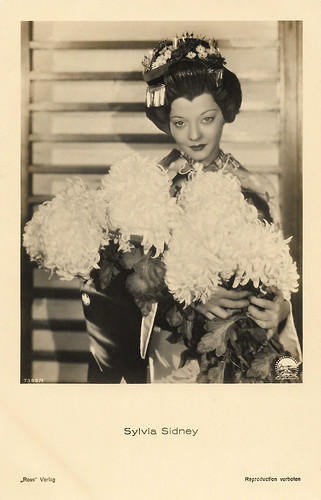
German postcard by Ross Verlag, no. 7392/1, 1932-1933. Photo: Paramount. Sylvia Sidney in Madame Butterfly (Marion Gering, 1932).

German postcard by Ross Verlag, no. 8795/1, 1933-1934. Photo: Paramount.
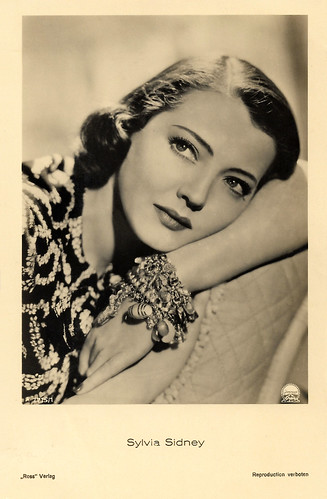
German postcard by Ross Verlag, no. A 1715/1, 1937-1938. Photo: Paramount.
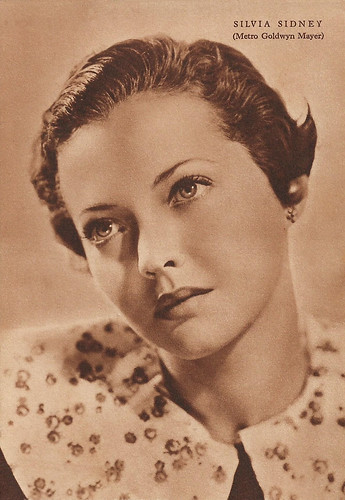
Italian postcard by Rizzoli & C., Milano, 1938. Photo: Metro Goldwyn Mayer.

French postcard, no. 686. Photo: Paramount.

French postcard by Editions E.C., Paris.
Sources: Wikipedia and IMDb.
No comments:
Post a Comment